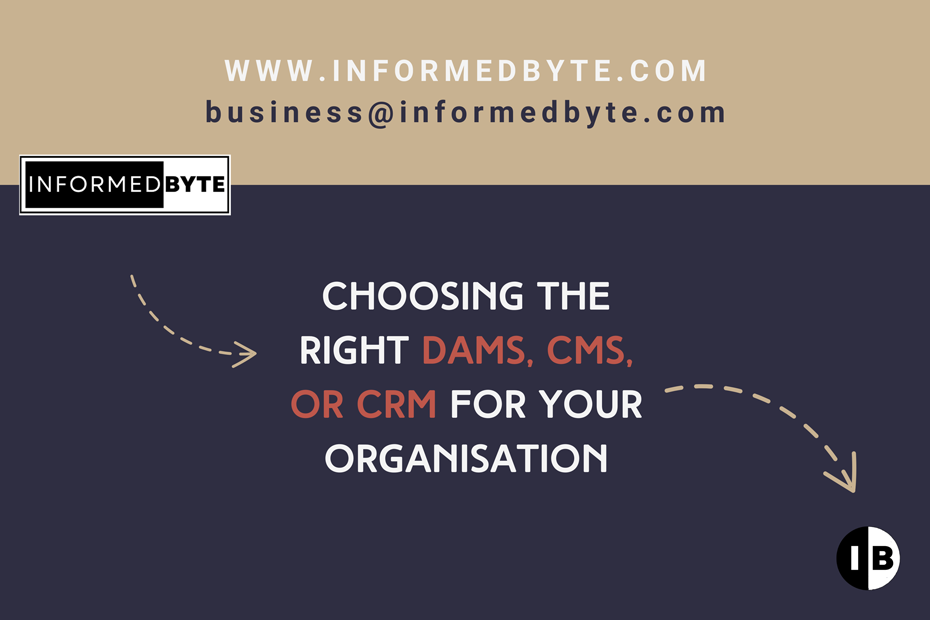Technology Deep Dive: Choosing the Right DAMS, CMS, or CRM for Your Organisation
September 16, 2025
Choosing the right Digital Asset Management System (DAMS), Content Management System (CMS), or Customer Relationship Management (CRM) system for your organisation is a critical decision that can significantly impact your operational efficiency and overall success. In this technology deep dive, we will explore the key considerations and best practices for selecting the most suitable system for your needs, drawing insights from Informed Byte.

Image credit by Gerd Altmann from Pixabay
When it comes to managing digital assets, content, and customer relationships, the right technology can make all the difference. You need a system that not only meets your current requirements but also scales with your organisation as it grows. This guide will help you navigate the complexities of choosing the right DAMS, CMS, or CRM by providing a comprehensive overview of each system, their benefits, and the factors you should consider during the selection process.
Understanding Digital Asset Management Systems (DAMS)
Digital Asset Management Systems (DAMS) are designed to store, organise, and manage digital assets such as images, videos, documents, and other multimedia content. These systems are essential for organisations that deal with a large volume of digital content and need a centralised repository to manage and distribute these assets efficiently.
Key Benefits of DAMS
-
Centralised Repository: A DAMS provides a single source of truth for all your digital assets, making it easy to find and access the content you need.
-
Improved Collaboration: With a DAMS, teams can collaborate more effectively by sharing and accessing digital assets in real-time.
-
Enhanced Security: DAMS offer robust security features to protect your valuable digital assets from unauthorised access and breaches.
-
Streamlined Workflows: Automate repetitive tasks and streamline workflows to improve productivity and reduce manual errors.
Factors to Consider When Choosing a DAMS
-
Scalability: Ensure the DAMS can scale with your organisation's growth and handle an increasing volume of digital assets.
-
Integration: Look for a DAMS that integrates seamlessly with your existing tools and systems.
-
User Experience: A user-friendly interface is crucial for ensuring adoption and maximising the system's potential.
-
Customisation: The ability to customise the DAMS to meet your specific needs is essential for long-term success.
Exploring Content Management Systems (CMS)
Content Management Systems (CMS) are used to create, manage, and publish digital content, typically for websites and online platforms. A CMS allows you to maintain control over your content without requiring extensive technical knowledge.
Key Benefits of CMS
-
Ease of Use: A CMS simplifies the process of creating and managing content, allowing non-technical users to contribute effectively.
-
Flexibility: CMS platforms offer a wide range of templates and plugins to customise your website and add new functionalities.
-
SEO Optimisation: Many CMS platforms come with built-in SEO tools to help improve your website's search engine rankings.
-
Content Scheduling: Plan and schedule content in advance to ensure a consistent publishing schedule.
Factors to Consider When Choosing a CMS
-
Content Types: Consider the types of content you will be managing and ensure the CMS supports them.
-
Customisation and Extensibility: Look for a CMS that allows you to customise and extend its functionalities to meet your unique requirements.
-
Performance and Scalability: Ensure the CMS can handle your website's traffic and content volume as it grows.
-
Support and Community: A strong support network and active community can be invaluable for troubleshooting and getting the most out of your CMS.
Delving into Customer Relationship Management Systems (CRM)
Customer Relationship Management Systems (CRM) are designed to manage interactions with current and potential customers. A CRM system helps you track customer data, manage sales pipelines, and improve customer service.
Key Benefits of CRM
-
Centralised Customer Data: A CRM system provides a comprehensive view of your customer data, making it easier to manage relationships and personalise interactions.
-
Improved Sales Management: Track leads, opportunities, and sales activities to optimise your sales process and close deals more effectively.
-
Enhanced Customer Service: A CRM system helps you provide better customer service by giving your team access to detailed customer information and interaction history.
-
Data-Driven Insights: Leverage analytics and reporting tools to gain insights into customer behaviour and make informed business decisions.
Factors to Consider When Choosing a CRM
-
Integration with Existing Systems: Ensure the CRM integrates seamlessly with your existing tools and systems.
-
Customisation and Flexibility: Look for a CRM that can be tailored to your specific business processes and needs.
-
User Adoption: A user-friendly interface and comprehensive training resources are crucial for ensuring successful adoption.
-
Scalability and Performance: Choose a CRM that can scale with your business and handle increasing volumes of customer data.
Making the Right Choice for Your Organisation
Choosing the right DAMS, CMS, or CRM for your organisation requires careful consideration of your specific needs, goals, and resources. Here are some steps to guide you through the selection process:
-
Assess Your Needs: Start by identifying your organisation's specific requirements and pain points. Consider the types of digital assets, content, or customer data you need to manage and the workflows you want to streamline.
-
Research and Compare Options: Conduct thorough research on the available DAMS, CMS, and CRM options. Compare their features, benefits, and pricing to find the best fit for your organisation.
-
Request Demos and Trials: Take advantage of demos and free trials to get hands-on experience with the systems you are considering. This will help you evaluate their usability and determine if they meet your needs.
-
Consider Long-Term Costs: Look beyond the initial purchase price and consider the long-term costs of ownership, including maintenance, upgrades, and support.
-
Seek Input from Stakeholders: Involve key stakeholders in the decision-making process to ensure the chosen system meets the needs of all departments and users.
-
Plan for Implementation and Training: Develop a detailed implementation plan and provide comprehensive training to ensure a smooth transition and successful adoption.
What's next?
By understanding the key benefits and factors to consider for each system, you can make an informed choice that aligns with your organisation's goals and needs. Remember to assess your requirements, research and compare options, request demos and trials, consider long-term costs, seek input from stakeholders, and plan for implementation and training. With the right system in place, you can streamline your workflows, improve collaboration, and drive better business outcomes.
Schedule an expert discussion
